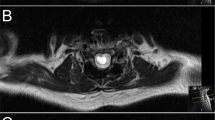Abstract
A 28-year-old man with a T12 incomplete paraplegia after a spinal cord injury (SCI) was referred for weight management in October 2011. He reported a weight gain from about 120 to 180.3 kg since his SCI. He put on a further 11.4 kg in January 2012 despite intensive dietetic treatment, including very low-caloric diet, anti obesity medication and active physiotherapy programme. He had undergone an uncomplicated laparoscopic Roux-en-Y gastric bypass successfully in March 2012. For the first 7 months after surgery, his total weight loss was 32.4 kg. He has shown functional improvement (6 min walking distance and Berg balance score). There were important improvements in body mass index; waist circumference; mid-upper arm circumference; triceps-skinfold thickness; mid-arm muscle circumference; total cholesterol; high-density lipoprotein-cholesterol; and low-density lipoprotein-cholesterol and triglycerides. This report describes the first UK morbidly obese SCI patient who has undergone gastric bypass surgery and highlights the provision of bariatric surgery as an option to consider if all nonsurgical interventions have been tried.
This is a preview of subscription content, access via your institution
Access options
Subscribe to this journal
Receive 12 print issues and online access
$259.00 per year
only $21.58 per issue
Buy this article
- Purchase on Springer Link
- Instant access to full article PDF
Prices may be subject to local taxes which are calculated during checkout
Similar content being viewed by others
References
Wong S, Derry F, Jamous A, Hirani SP, Grimble G, Forbes A . The prevalence of malnutrition in spinal cord injured patients—a UK multicentre study. Br J Nutr 2012; 108: 918–923.
National Institute for Health and Clinical Excellence (NICE): Guideline on the prevention, identification, assessment and management of overweight and obesity in adults and children. London: NICE 2006 Available from http://guidance.nice.org.uk/CG43/NICEGuidance/pdf/English (accessed 20 February 2013).
Wong S, Derry F, Graham A, Grimble G, Forbes A . An audit to assess awareness and knowledge of nutrition in a UK spinal cord injuries centre. Spinal Cord 2012; 50: 446–451.
Laughton GE, Buchholz AC, Martin Ginis KA, Goy RE . Lowering body mass index cutoffs better identifies obese persons with spinal cord injury. Spinal Cord 2009; 47: 757–762.
Van Hedel HJ, Wirz M, Curt A . Improving walking assessment in subjects with an incomplete spinal cord injury: responsiveness. Spinal Cord 2006; 44: 352–356.
Lemay JF, Nadeau S . Standing balance assessment in ASIA D paraplegic and tetraplegic participants: concurrent validity of the Berg Balance Scale. Spinal Cord 2010; 48: 245–250.
Coggrave M, Norton C, Wilson-Barnett J . Management of neurogenic bowel dysfunction in the community after spinal cord injury: a postal survey in the United Kingdom. Spinal Cord 2009; 47: 323-330.
Sileri P, Franceschilli L, Cadeddu F, De Luca E, D’Ugo S, Tognoni V et al. Prevelence of defaecatory disorders in morbidly obese patients before and after bariatric surgery. J Gastrointest Surg 2012; 16: 62–66. discussion 66-67.
Breasted JH . The Edwin Smith Surgical Papyrus. Vol. 1, University of Chicago Oriental Institute Publications: Chicago, IL, USA, 1930, pp 316–342.
Guttmann L . Management of Spinal Fractures, Spinal Cord Injuries, Comprehensive Management and Research. Oxford Press, Blackwell Scientific Publications: London, UK. pp 7–21 1970.
Klein S, Ghosh A, Cremieus PY, Easpen S, McGavock TJ . Economic impact of the clinical benefits of bariatric surgery in diabetes patients with BMI⩾35 kg/m2. Obesity 2011; 19: 581–587.
Acknowledgements
We thank Mr Marwan Farouk and Dr Claire Nightingale, Ms Fayth Armitage, Ms Lynsey Spillman, Mrs Judith Earl and Mrs Liz Pryke in facilitating this case. We also thank Dr Allison Graham and Dr Joost van Middendorp to review the manuscript. Written consent to publish was obtained. Written informed consent was obtained from patient before data collection and case report publication.
Author information
Authors and Affiliations
Corresponding author
Ethics declarations
Competing interests
The authors declare no conflict of interest.
Additional information
Contributors: All authors have read and approved the final version submitted for publication. All authors have made substantial contributions and final approval of the conceptions, drafting and final version. SW—data collection, data analysis, manuscript preparation. TB—physiotherapy intervention, data collection, manuscript revision. LPC–psychological intervention, manuscript revision. MC—nursing intervention, manuscript revision. AF—academic supervision, manuscript revision. SA—Surgical intervention, manuscript revision. MB—Clinical supervision, manuscript revision and guarantor of the paper.
Rights and permissions
About this article
Cite this article
Wong, S., Barnes, T., Coggrave, M. et al. Morbid obesity after spinal cord injury: an ailment not to be treated?. Eur J Clin Nutr 67, 998–999 (2013). https://doi.org/10.1038/ejcn.2013.129
Received:
Revised:
Accepted:
Published:
Issue Date:
DOI: https://doi.org/10.1038/ejcn.2013.129
Keywords
This article is cited by
-
Effect of a computerized decision support system on the treatment approach of stage III or IV pressure injury in patients with spinal cord injury: a feasibility study
BMC Health Services Research (2023)
-
Guideline Approaches for Cardioendocrine Disease Surveillance and Treatment Following Spinal Cord Injury
Current Physical Medicine and Rehabilitation Reports (2018)
-
Improvement in weight loss and ambulation outcomes after gastric sleeve surgery for a person with chronic motor-incomplete tetraplegia: clinical case report
Spinal Cord (2016)
-
Knowledge, attitudes and practices of medical staff towards obesity management in patients with spinal cord injuries: an International survey of four western European countries
Spinal Cord (2015)


